EVERYWHERE DIFFERENTLY (CONDENSED)
By Andrew Maerkle
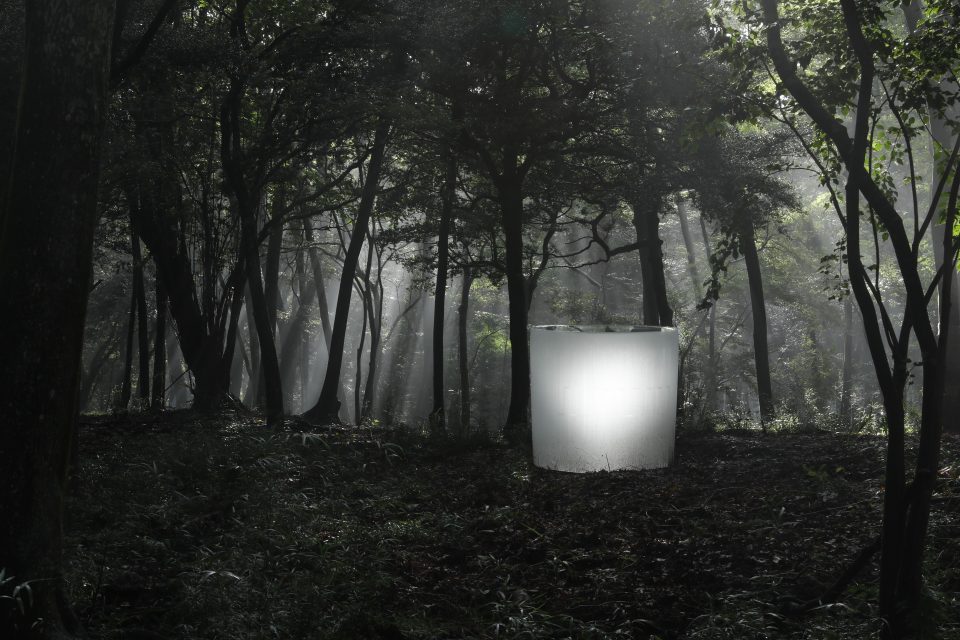
Air Burial (Hakone) (2017–18), solid cast glass with as-cast surfaces. Installation view, Pola Museum of Art, Hakone. Photo Koroda Takeru. All images, unless otherwise noted: © Roni Horn, courtesy Roni Horn and Hauser & Wirth.
Active since the 1970s, Roni Horn is one of the most accomplished American artists working today. Emerging in the wake of minimal and conceptual art, Horn developed a unique practice that distils diverse artistic strategies and wide-ranging literary, intellectual, and experiential references into sculptures, photographic installations, large-scale mixed-media drawings, artist books, and other works. Early in her career, Horn began traveling between the United States, where she is based in New York, and Iceland, where the harsh, arctic climate and volcanic landscape, and the adaptations locals have made to those conditions, have been a continuous source of inspiration for her.
Horn’s work is currently on view in the artist’s first solo exhibition at a Japanese institution, “When You See Your Reflection in Water, Do You Recognize the Water in You?,” held by the Pola Museum of Art in Hakone; it is also the first large-scale solo exhibition the Pola Museum has dedicated to a contemporary artist. The exhibition covers 40 years of Horn’s career, spanning from her enigmatic cast glass sculptures to photographic projects shot in Iceland and Bouquet of Emily (2006–07), with fragments of Emily Dickinson’s writing implanted into aluminum sticks that are propped casually against the gallery wall. A concurrent solo exhibition of paired photographs of birds opened at the start of this year at Taka Ishii Gallery, Tokyo.
Shortly after the Pola Exhibition opened in September 2021, ART iT’s Andrew Maerkle conducted an interview with Horn for the exhibition catalogue. What follows is a condensed version of that interview. The full text of the interview can be found in Pola Museum of Art, Pola Art Foundation, ed., Roni Horn: When You See Your Reflection in Water, Do You Recognize the Water in You?, exh. cat. (Tokyo: Heibonsha, 2021), 130–36.
“Roni Horn: When You See Your Reflection in Water, Do You Recognize the Water in You?” continues through March 30 of this year. “Roni Horn: bird” opened at Taka Ishii Gallery on January 8 and continues through February 5.
You once described Iceland as an “erotic adventure.”
Well, when you’re a pervert, you’ve really got to make do with the options available. In those days you found your erotic adventures wherever you could, and it was not a difficult thing to do once I recognized the depth of my attraction to Iceland. Since I’m a conceptually oriented person, that side will always be there. But the erotic aspect was key to my travels in Iceland. It’s a sensual experience. There’s a lot of physicality, whether you want it or not. The weather is intrusive. You’re never without it. Whether it’s the wind or the rain or extreme temperature shifts, the weather is there, and it’s affecting how you’re feeling and what you’re doing and how you’re doing it. I used to travel with a tent, so add that in and you’re really at the mercy of the elements. But then the sun would come out and you’d be standing in a little ray of warmth while everything around you was cold. All of that is part of a sensuality that’s not terribly visible but absolutely powerful—palpable—in my experience of Iceland.
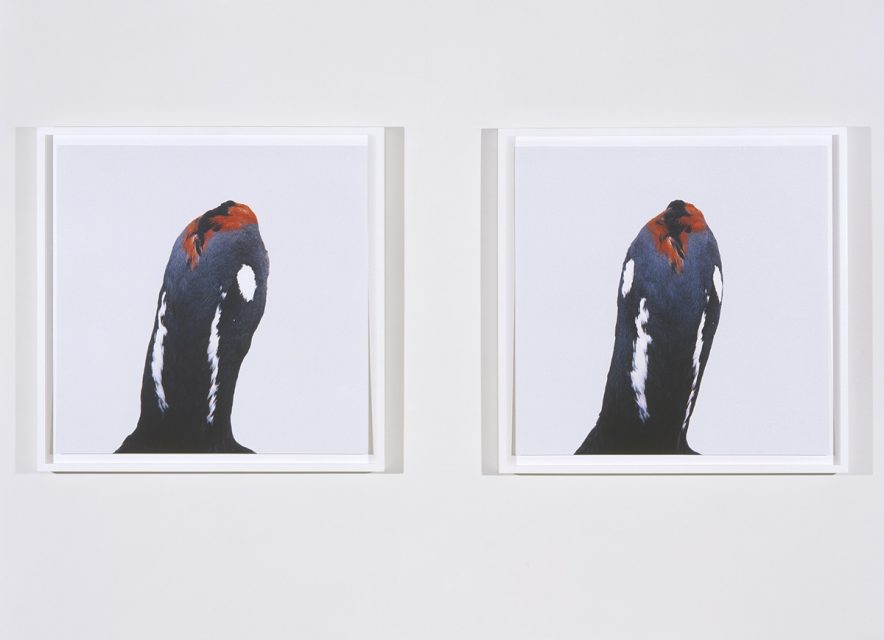
bird, (1998/2008), detail, pigment prints on paper, 55.9 x 55.9 cm each, set of 10 pairs (20 photographs). © Roni Horn, courtesy of the artist, Taka Ishii Gallery, and Hauser & Wirth.
I find an erotic structure in many of your works. Even your idea of the “pair object” or “paired image” presents an erotically charged situation through the mechanism of the double take, which is where desire and doubt intersect.
Sure. Think about Dead Owl (1997), which is probably the most important paired image. People are always asking whether it’s the same image or two images, two owls. That tells me you can never get away from doubt. It also comes up with the glass pieces. Here is this perfectly transparent form, but I’m often asked “What’s inside?” Even the most transparent situation inspires doubt and incredulity. I find that vicious circle of not knowing very compelling. I cultivate it in my work. It keeps the viewer engaged or active in the experience.
In fact, the original motivation for the “Pair Object” series—and of course this is only what I’m conscious of—was to literally incorporate the viewer in the work. The first work of this kind, Things That Happen Again: For Two Rooms (1986), features two identical machined objects placed in different rooms. They are technically identical, but “identical” is an oxymoron, as two things are always in different places, and therefore not identical. My idea in putting one object in one room and a duplicate object in a second room was to give the viewer a unique experience followed by a repetition of it. The two experiences are completely different. The first is a fresh first time. The second is shadowed in the history of that first time.
Is doubling or repetition a gesture toward androgyny?
I think of androgyny more as a multiplying than a doubling per se. I never had a strong identification with the two genders I was offered when I was growing up. I see shades of gender, degrees toward the masculine and degrees toward the feminine and everything in between. And I was somewhere in between, feeling like I had the best of both sides without being either. To me androgyny is the integration of difference, and that understanding has allowed me to live the life I’ve lived and do the kind of work I do.
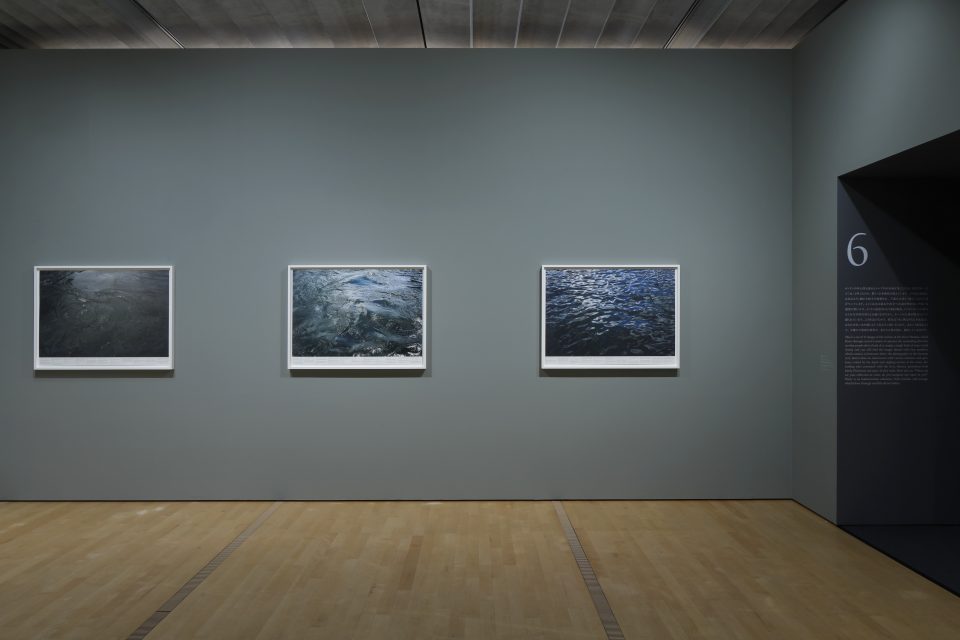
Still Water (The River Thames, for Example) (1999), detail, 15 photographs and text printed on uncoated paper, offset lithography. Photo Koroda Takeru.
Let’s jump from Eros to death, or rather our attraction to death. As I looked at Still Water (The River Thames, for Example) (1999) here at the Pola Museum of Art, the seductiveness of the river came across in the images and texts.
I think people who choose that form of suicide are not just choosing death, they’re choosing disappearance, and that’s a big part of the energy of the Thames. It’s a tidal river, so it’s going up and down six or seven meters a day, and it has heavy embankments that have constricted the flow, so it’s much more aggressive than it originally was. These two factors make it highly lethal. When I looked at the river, I thought OK, if you go in, chances are you’re not coming out. That was before I had done any research. You could see all the eddies and the power of the water. It was mesmerizing. It was like you were being drugged or subdued or, indeed, seduced.
That observation allowed me to swim in the Thames quite thoroughly—its history, its physical qualities, all that one could know about it technically. But the biggest part of my observations was based in the experiential, and with water it’s endless. I call water the “ultimate conjugation.” It brings everything together, whether visibly or not. One of the many paradoxes of water is how it’s always in direct communication with other things—often filthy or not very savory things—yet still is transparent. There’s something radical to me about that.
Pollution, microplastics, sewage, trash, dead bodies.
That brings up another point: When you talk about water, you’re talking about yourself. What’s out there is in here. In my body. Water is life giving and one would think that it therefore needs to have a certain degree of purity. But water and its association with purity are changing, and now the definition of purity has to include “forever chemicals” and microplastics. What does that mean? You have rainwater full of forever chemicals through the cycle of evaporation and condensation. If you wade into the ocean, you have whatever pharmaceutical you could possibly want right there in the water with you, from methamphetamines to Zoloft. People are pissing out everything they metabolize and it goes into the water.
And there’s only one water, ultimately, which I think is a pretty tough reality for us to accept. We don’t really respect the value of water. I think Coca-Cola does, or Nestlé, or any of the other big bottling companies going around quietly buying up local water sources. You also have China going into Tibet and securing the world’s largest fresh water sources for its population. From a political point of view this should not be an option, not even for a country. There should be no impediment or restriction to the distribution of water, but it’s very much happening in our time.
Still Water broaches the idea of water as a text, and reading informs many of your other works too. Is that something you consciously return to?
Such a tiny part of what I do is conscious, to be honest. There’s some other level of operation I’m subsumed in. But I do see that I frequently come back to reading as a form of viewing, as in the White Dickinson works. I regard the White Dickinsons as a view in a room, as opposed to a room with a view. It’s the idea of seeing beyond what one can physically apprehend. I love that a simple statement like “Two butterflies went out at noon” can read as an absurd image while also being a precise articulation of something that has happened millions of times in the past but was observed so precisely, so factually and put down in writing. I call such texts “keys” and “cues.” A “key” is a way in, and a “cue” is a prompt, it gives you direction. That’s how I think of those objects. Text is a launching pad for a view beyond the visible.
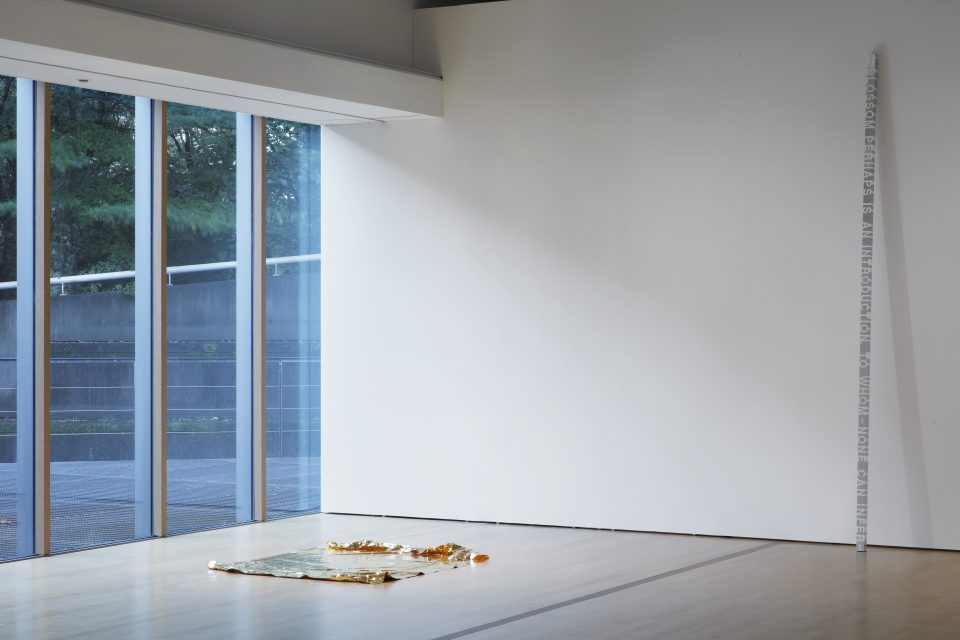
At left: Gold Field (1980/94), 99.99% gold foil, fully annealed; at right: Bouquet of Emily (2006–07), detail, solid aluminum and cast white plastic in 6 parts. Photo Koroda Takeru.
I read your Vatnasafn / Library of Water (Iceland) (2003–07) project, which is housed in a former library building in Stykkishólmur, Iceland, and touches on issues of preservation and community, as a response to Iceland’s transition into a more neoliberal, privatized society. Or at least it anticipates the collapse of Iceland’s financial system in 2008, a year after the project opened.
There is an aspect of that. I would say up to about the year 1995 or so you might not have had any millionaires in Iceland. Then you started getting all these cheap flights in and out and everybody seemed to have lots of money to spend, and a lot of it was stolen or falsely generated. It doesn’t make a difference what subgroup or culture you’re in, there’s always the same percentage of assholes. Even though Iceland was kind of idyllic, there were literally two dozen guys who just went crazy taking large loans from the banks and defaulting. And since those banks were owned by the people of Iceland, the people were stuck with the debt. It was a real reckoning.
Returning to the paired images—works like This is Me, This is You (1998–2000) and You are the Weather (1994–96), as well as Dead Owl—in the catalogue for your exhibition at Fotomuseum Winterhur in 2003, If on a Winter’s Night . . . Roni Horn . . ., Thierry de Duve writes about the viewer’s movement back and forth between images to see how they are the same or different as “time becoming space.” Does that aspect of the work have anything to do with your own movement back and forth between New York and Iceland?
All of the works you mention focus on identity. In the case of You are the Weather, which came first, I was imagining the possibility of every individual as a multitude. I wanted to see whether I could create a likeness of a culture through a specific face. The photographs were originally intended for a book that I titled Haraldsdóttir, meaning “daughter of Harald”—anonymous in a sense. But once I started working with the material I realized that all of her multitude, or so much of it, is drawn out by the weather. That’s when it became an installation. The image of aggression, of androgyny, of masculinity, anything you see there comes from her dealing with the physical reality around her. And people bring different degrees of sensitivity, awareness, and curiosity to the installation. Some think it’s all the same image. Others recognize the uniqueness and nuance that distinguishes each of the images. That’s the range. My game is to draw out that experience, to dwell in it.
The installation Pi (1997–98) also prompts viewers to move through the space through a simple intervention.
Well, when you put something up high on the wall, you push people into the center of the room—unless they prefer to crane their neck awkwardly to see each image up close. Moving back, taking more distance allows you to see the relationships between the images. It discourages the viewer from giving any one image more importance than any other. You wind up with a horizon, where things are leveled into one—that is, you can see the collection of images and relationships as one thing. With You are the Weather, you view it up close because the images are much smaller and the nuances are subtler.
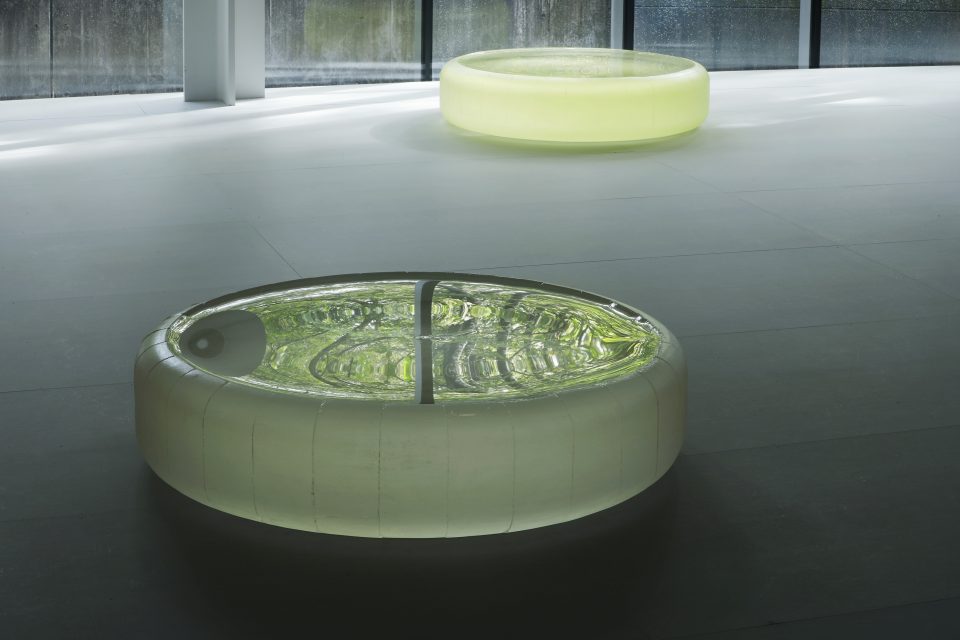
Untitled (“I get all the news I need from the weather report.”) (2018–20), solid cast glass with as-cast surfaces with oculus. Photo Koroda Takeru.
To what extent do you employ emptiness as a space for people to project themselves into your works? The White Dickinsons nod to emptiness because they are propped innocuously against the wall. Despite being extremely heavy, solid objects, the glass pieces seem empty because they are transparent. When you’re in a room with them, it’s like they come and go.
I’m not sure I connect it with emptiness, but the glass pieces are quiet and allow the viewer their own time. I heavily depend on nuance in my engagement with my audience. But I’ve had people criticize Gold Field (1980/82) as crass sensationalism. I don’t think it is, because sensationalism is about choosing something for the sake of making a certain impact. I chose gold to be what it is, not to make an impact beyond itself. I was just exposing its reality. Similarly, people don’t know what they’re looking at when they look at the glass pieces, but those things are like a smack in the face if you know what’s going on. It’s there, sort of in the same way the architecture is. I like to think these works are instigators of experience, where the experience is integral to the object’s identity.
Roni Horn: Everywhere Differently (Condensed)
